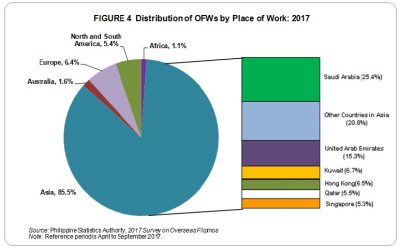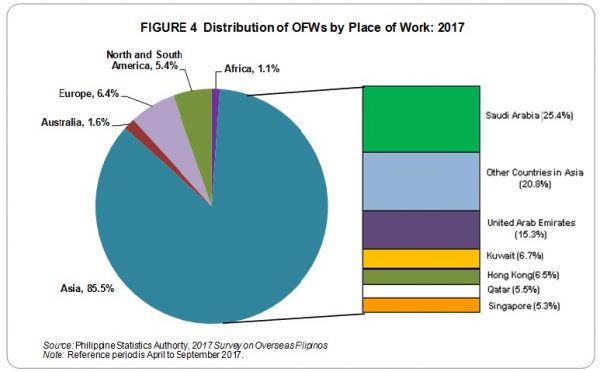NEW YORK, NY – To some recipients in the Philippines, money sent by working family members in the Middle East or elsewhere overseas could be a lifeline, considering that each dollar received is worth around PhP 52 today based on Bloomberg’s currency exchange rate on November 26. To others, the remittances enable them to buy goods – especially high-ticket items and services during the current Christmas season – that they could otherwise likely not be able to afford if they were working in their home country and earning in pesos.
The total amount of money received by family members, relatives and dependents residing in all regions of the world, continued its annual rise over the last several years. In 2017 global remittances reached a record $613 billion, growing by seven percent over 2016, according to an April 2018 World Bank report. The 2018 figure is expected to reach $642 billion.
The top three largest sums of money coming from overseas family members were by recipients in India, China, and the Philippines. The remittances were around $69 billion, $64 billion, and $33 billion, respectively, according to World Bank estimates. Ranking Nos.4, 5 and 6 were Mexico, Nigeria, and Egypt, with $31 billion, $22 billion, and $20 billion respectively.
How do the three largest remittance amounts compare with these countries’ gross domestic product (GDP) numbers? For India, the $69 billion remittance amount is a mere 2.65 percent of its total 2017 economic output of $2.597 trillion (IMF’s figure: $2.611 trillion). For China the total $64 billion received from overseas is even smaller – just a minuscule one-half of one percent of its $12.237 trillion (IMF’s number: $12.015 trillion) total 2017 GDP.
But for the Philippines the $33 billion of money coming from overseas represents a significant 10.5 percent of the country’s 2017 GDP of $313 billion.
Note the comparative per-capita remittance amounts among the top three recipient countries. With China’s population now exceeding 1.4 billion, and India’s inhabitants now numbering over 1.36 billion, the per-capita remittance amounts were quite small – just a little over $45 and $50 respectively. But for 107 million people in the Philippines, this amount was six times larger at $308.
These per-capita remittance numbers are meaningful only if we assume that every resident receives something from an overseas family member, which is not the case. China and India have huge populations that are over 13 times and 12 times larger respectively, than that of the Philippines, so their per-capita figures have necessarily got to be much smaller. .
The Philippine Statistics Authority (PSA) however shows us a different picture. It is about OFW remittances. In a May 18, 2018 report, it shows that in the six months between April and September of 2017, some 2.3 million workers remitted close to $4 billion ($3.946 billion converted from $205.2 billion pesos at an exchange rate of 52 pesos to a US dollar)
If we assume that the average total monthly remittance amounts are more or less the same, a 12-month total remittance amount would be twice the six-month number, or roughly 410.4 billion pesos amounting to $7.892 billion. This amount is far smaller (less than a quarter) of the $33 billion reported as going to the Philippines by the World Bank.
This writer assumes the huge difference between the PSA’s figure of $7.892 billion and the World Bank’s $33 billion amount as the total remittances in 2017 by overseas Filipinos to people in the Philippines is because the PSA number is on OFW remittances only, whereas the $33 billion figure includes remittances by Filipinos besides just OFWs.
The PSA report shows that the average remitter sent PhP 74,000 amounting to $1423.The largest average remittance was PhP 223,000 ($4288) by male workers from the strong-currency city-state Singapore while the smallest average remittance was PhP 37,000 ($711) from female remitters in Malaysia. Not all overseas workers sent money. Below are interesting demographics:
- More than three-quarters (76.3%) of the workers are between 25 and 44 years of age
- Females outnumber males: 1.255 million to 1.085 million
- Asia (where Middle East is included in the report) has 85.5% of OFWs, with the others in Europe (6.4%) North and South America (5.4%) Australia (1.6%) and Africa (1.1%)
- Asia subdivided into East Asia, Southeast and South Central Asia (SCA) + Western Asia
- East Asia including China, Hong Kong, Japan, South Korea, and Taiwan has 18.9%
- Southeast + SCA (Brunei, Cambodia, Indonesia, Malaysia, Singapore) share: 9.5%
- Western Asia has the largest share: more than half (57.1%) of OFWs in Asia
- Saudi Arabia and UAE have the bulk (25.4% and 15.3%) of OFWs in Western Asia
On the huge ($25 billion) difference between PSA’s nearly $8 billion and the World Bank’s $33 billion: In 2010 total remittances already amounted to $19.4 billion (we assume from all Filipinos) as economist Gerardo P. Sicat wrote on October 3, 2012 in The Philippine Star.
Kumar (Kem) Balani has an AB Journalism degree from the University of the Philippines and an MA in Politics from New York University. He is founder and publisher of Biz India Online News since 2002. Go to www.BizIndia.net to read book reviews, features, news, opinion columns, and videos on business, entertainment, investing, law, sports, technology, and more.
This column first appeared in the Daily Tribune in the Philippines on Sunday, December 09, 2018. Read Kumar Balani’s columns in that newspaper: http://tribune.net.ph/index.php/author/kumar-balani/








